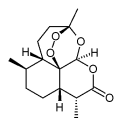Can an ancient Chinese herb help in the battle against cancer? Researchers at the University of Washington are studying the Chinese herb called artemisinin--extracted from the plant Artemesia annua L., commonly known as wormwood--as a potential cancer treatment.
The compound is widely used in Asia and Africa to combat the mosquito-borne disease malaria. Artemisinin reacts with the high iron concentrations found in the malaria parasite. When artemisinin comes into contact with iron, a chemical reaction ensues, spawning charged atoms called free radicals. Free radicals then attack cell membranes, breaking them apart and killing the single-cell parasite.
UW professor and bioengineering researcher Dr. Henry Lai thought that the compound may prove useful with cancer cells, which need much iron to replicate DNA when the cells divide. As a result, cancer cells have a higher iron concentration than normal cells.
Testing his hypothesis, Lai and his colleague, Dr. Narendra Singh, pumped up cancer cells in his laboratory with even more iron, then introduced artemisinin to selectively kill them. The results were impressive and effective. After only eight hours, 75 percent of the breast cancer cells in a petri dish were obliterated; after 16 hours, nearly 100 percent of breast cancer cells were dead.
"Not only does it appear to be effective, but it's very selective," said Lai. "It's highly toxic to the cancer cells, but has a marginal impact on normal breast cells."
If future animal and human tests prove as promising as initial trials, a nontoxic pill could be taken on an outpatient basis to combat cancer.
The compound is not new. For centuries, the Chinese folk practitioners used it successfully to combat malaria. Over time, the treatment with artemisinin was lost, then rediscovered during an archaeological dig in the 1970s that unearthed recipes for ancient medical remedies. A purified form of the plant compound is now the World Health Organization's (WHO) drug of choice for treating malaria in many areas, especially where antibiotic-resistant strains have emerged.
The University of Washington research appears in the November 2001 issue of the Journal of Life Sciences. Because malaria is not a problem in the United States, artemisinin supplements are hard to find. We have learned that a California pharmaceutical company produces beta-artemether--a fat-soluble version of artemisinin that Dr. Lai believes might combat cancer even better than the water-based formulation used in initial studies.
Bioavailability of the product has been confirmed by Dr. Singh. For more information, call the Wellcare Pharmaceutical Company toll-free at 877-728-2073 or visit their Web site at www.hepalin.com.
COPYRIGHT 2002 Saturday Evening Post Society
COPYRIGHT 2002 Gale Group



